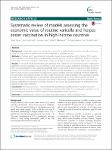Systematic review of models assessing the economic value of routine varicella and herpes zoster vaccination in high-income countries
Damm, Oliver
Ultsch, Bernhard
Horn, Johannes
Mikolajczyk, Rafael T.
Greiner, Wolfgang
Wichmann, Ole
Background: A systematic review was conducted to assess the cost-effectiveness of routine varicella and herpes zoster (HZ) vaccination in high-income countries estimated by modelling studies. Methods: A PubMed search was performed to identify relevant studies published before October 2013. Studies were included in the review if they (i) evaluated the cost-effectiveness of routine childhood or adolescent varicella vaccination and/or HZ vaccination targeting the elderly, and if they (ii) reported results for high-income countries. Results: A total of 38 model-based studies were identified that fulfilled the inclusion criteria. Routine childhood or adolescent varicella vaccination was cost-effective or cost-saving from a payer perspective and always cost-saving from a societal perspective when ignoring its potential impact on HZ incidence due to reduced or absent exogenous boosting. The inclusion of the potential impact of childhood varicella vaccination on HZ led to net quality-adjusted life-year (QALY) losses or incremental cost-effectiveness ratios exceeding commonly accepted thresholds. Additional HZ vaccination could partially mitigate this effect. Studies focusing only on the evaluation of HZ vaccination reported a wide range of results depending on the selected target age-group and the vaccine price, but most found HZ vaccination to be a cost-effective or marginally cost-effective intervention. Cost-effectiveness of HZ vaccination was strongly dependent on the age at vaccination, the price of the vaccine, the assumed duration of protection and the applied cost per QALY threshold. Conclusions: While HZ vaccination is mostly considered cost-effective, cost-effectiveness of varicella vaccination primarily depends on the in- or exclusion of exogenous boosting in the model. As a consequence, clarification on the role of exogenous boosting is crucial for decision-making regarding varicella vaccination.
No license information

